The Heathkit SB1000 amplifier. Famous for having a smoked power transformer.
Not a kit, the Heathkit name was just a marketing "badge" applied to the AL-80A amplifier built by Ameritron of Ohio, just before the Ameritron name and catalog were sold to Martin of MFJ and moved to Mississippi.
Here's a stock shot of the front.
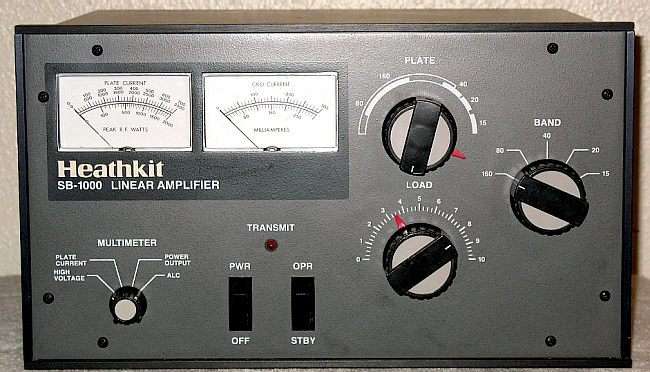
Yeah, Heath was already on the ropes for the first time when this was sold around 1988 or so. They had discontinued their ham gear years before, but Ameritron had been, er, "bought" from Dennis, the "Amp Supply" and "Dentron" guy and moved from North Carolina to Ohio. It's easy to imagine that if Heath offered to buy a production run of AL-80A amplifiers with their front-panel artwork on it, Ameritron would be happy to sell them.
Stock inside shots:
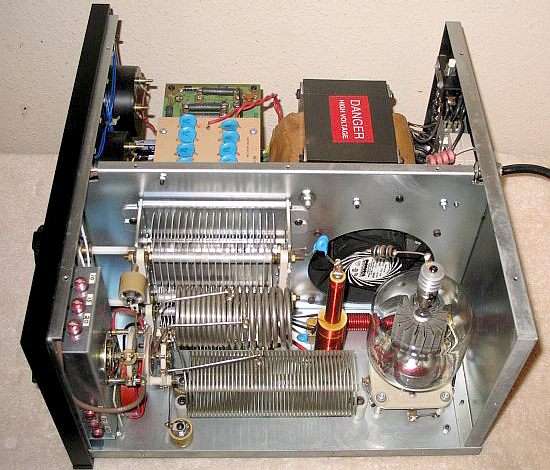
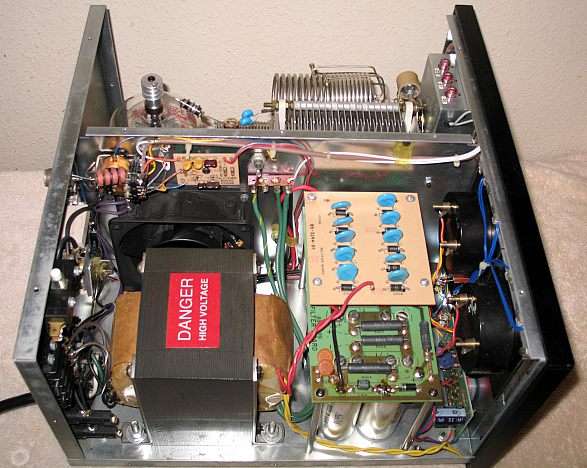
And Dennis Had was still in North Carolina last I heard, making tube-type audio gear. Said he would never design another product for ham radio again as long as he lives.
It's not the original "AL80" from North Carolina. And it's not the "AL80B" that MFJ redesigned to make in Mississippi. This one is the in-between "AL-80A" model in disguise.
Not sure why, but when you find one of these for sale the power transformer is nearly always croaked. This one was. Made the purchase price quite reasonable. The search was on for an affordable replacement. Ended up using the transformer that Ameritron sells as the replacement for the current-day AL80B.
But it won't fit. It's bigger, which should be a good thing. You might be tempted to guess that the factory transformer was too small, and that's why they all go bad after 20 years or less. But a quick comparison the the stock HV transformer in the two-tube SB-220 model shows that they're nearly the same size.
Go figure. The price is right for the Ameritron 406-1109-2C transformer. Cheaper to buy directly from them than any other source of the same or similar part
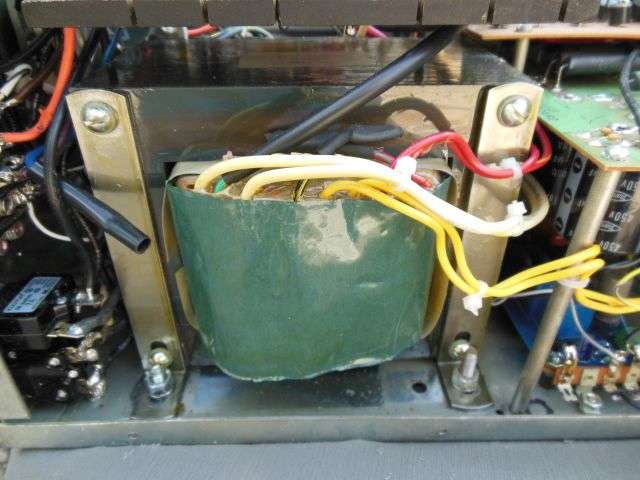
First challenge is to make it fit. It's larger. The filter capacitor board gets moved about a half-inch towards the front. Since we replaced the tall "computer grade" filters with smaller snap-in style filter caps there is room to mount a ChinaBay soft-start board on the deck under them.
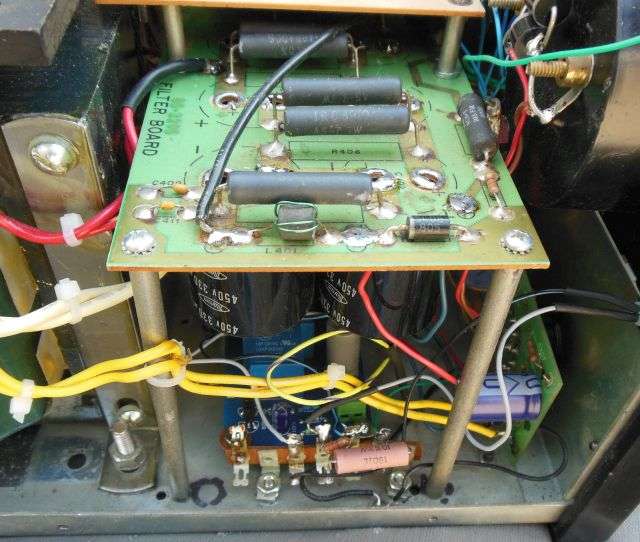
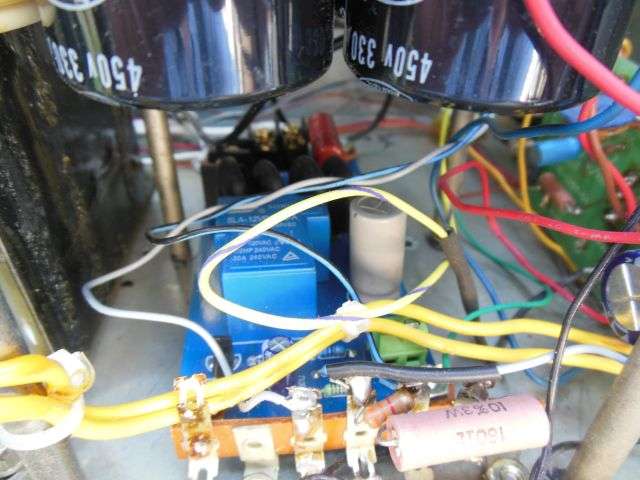
One reason to rehab this amplifier was to use it for testing tubes at full power. I can test them cold for gas and shorts, but I needed a way to match tubes for zero-bias idle current and to see how much power a tube can deliver. No other effective method to see if a used tube is weak. And finding out that one of a pair of tubes is twice as strong as the other is equally bad news.
But putting a used tube in an amplifier can create a hazard to the amplifier if it goes "SNAP!" when you key it. Most of what we did to upgrade this one was to make it resist damage from a tube that breaks down under load.
Next strategy is to upgrade the high-voltage rectifier diodes to 6-Amp rated parts. This is overkill for the normal load current, but increases the surge rating of the power supply. The original setup used only two strings of five diodes. We doubled up each single diode as a series pair. Doesn't improve the current rating, since they are all in series. But it cuts the reverse voltage on each diode in half. The original power-line fuses are now 7.5-Amp breakers. I suspect that a fair number of 'bad' SB-1000 transformers were croaked by a "no-blow" fuse.

The original plate choke is very different from the one that Ameritron uses. It was roached, so we installed the current-day AL80B choke, also bought from Ameritron.
Original:
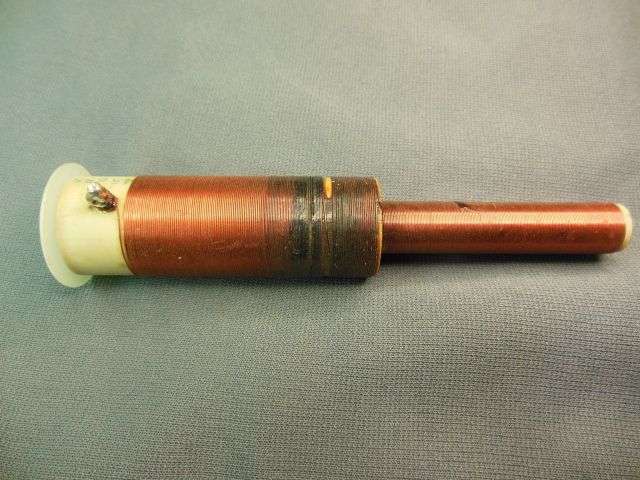
Replacement:
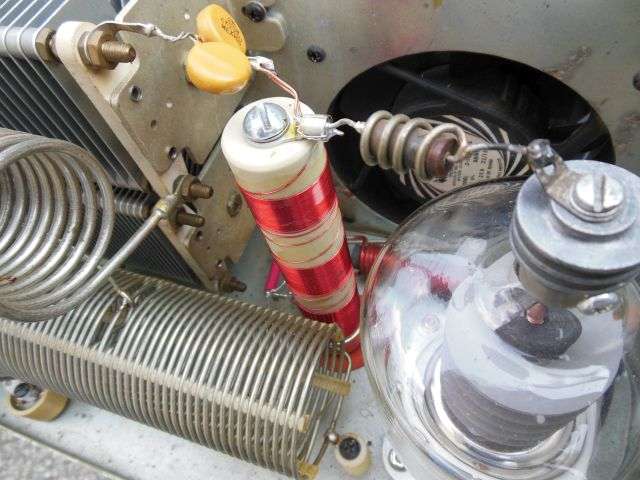
A large "glitch" resistor is now in the high-voltage line between the power supply and the plate choke. It's built from a series string of eight 25-ohm 30-Watt wirewound resistors. Adds up to 200 ohms at a theoretical power rating of 240 Watts. They're spaced way too close to get that full power rating. You have to expose all of the resistor's surface to circulating air to get that rating. But with the amplifier running at 1000 Watts DC input to the tube this is only 1/3 of an Amp, more or less. At this power level, each resistor only has to dump a little under 3 Watts. The voltage drop through 200 ohms from the high voltage would only be 66 Volts. Losing 66 Volts out of 3000 is not enough to sacrifice performance in any significant way. And Ohm's law says that the max surge current the tube can draw from 3000 Volts is now 15 Amps. Way more than is safe for the tube, but not too hard on the 6-Amp rectifiers or the plate choke, so long as the breakers trip out promptly.
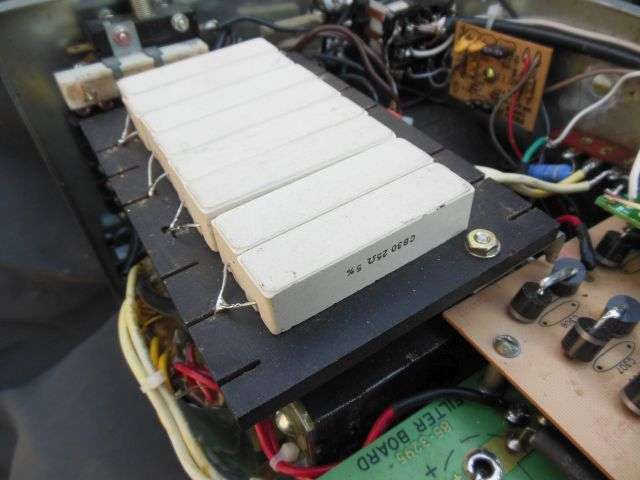
A dead-shorted tube should not damage the amplifier's power supply.
The Ameritron 406-1109-2C power transformer supplies all the operating voltages needed for HV, tube filament, relay and lights. But it's meant to be used all over the planet and to accommodate all manner of wacky line voltages. The hookup we ended up using to match a 240-Volt power line voltage was a combintion of educated guesswork and trial-and-error. We did *NOT* make any attempt to figure out a 120-Volt setup. No point.
These 7.5-Amp breakers should be sufficient.
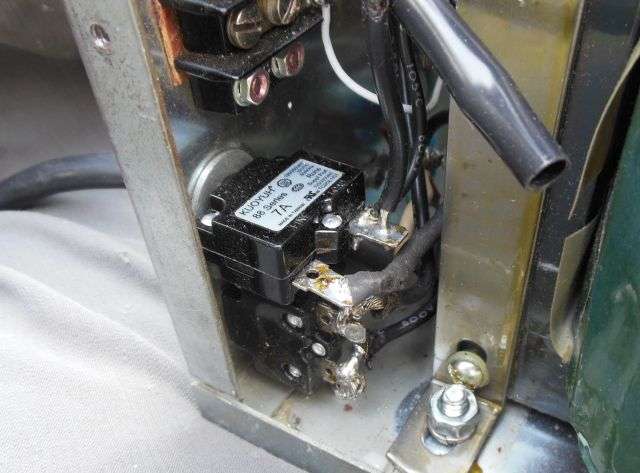
The original 10-Watt zener diode used for fixed cathode bias is gone, replaced with a board full of 3-Amp 1N5408 rectifier diodes in series. The bias-voltage regulation is not quite as good as a zener, but 3-Amp rectifiers are a lot tougher than a 10-Watt zener diode, and should not be damaged by a brief surge. The other advantage of using this bias board is the knob added to the front panel that selects the bias voltage on the tube. It's wired for zero bias, 5, 10 and 20 Volts of cathode bias. The zero bias setting is useful for tube matching. The number written on a paper tag glued to a new chinese 3-500Z is the zero-bias plate current for that tube. Not sure what plate voltage they use to make that measurement, but it does permit comparison from one tube to the next for matching purposes.
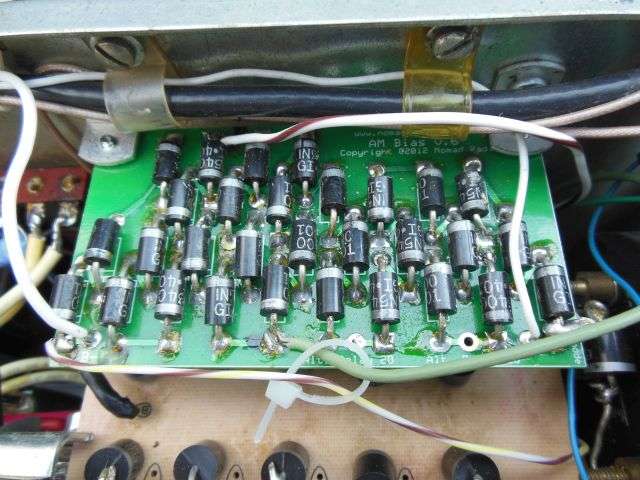
Either 5 or 10 Volt bias is fine for SSB. It will breathe a lot easier on AM with 20 Volts. This ugly knob selects one of four bias modes. It mounts in the hole where the "TX" indicator used to be. Much easier than lining up a new hole in both the chassis and faceplate.
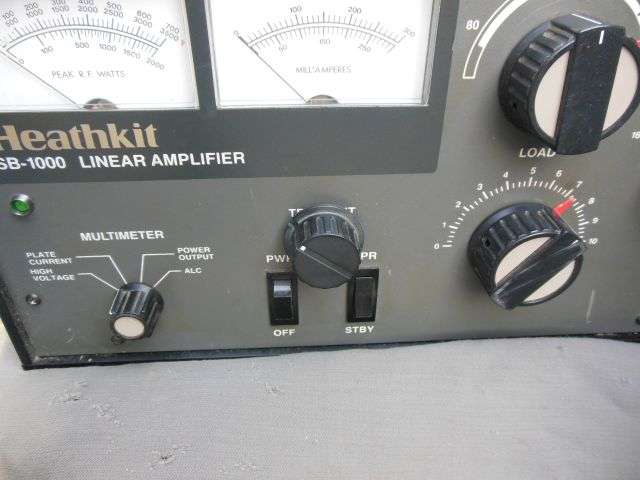
The one remaining item on the modification wish list is to beef up protection for the meters. A current surge from a bad tube can damage either or both meters. A back-to-back pair of diodes will do the job as a rule, but I would rather have a 'sacrificial' 1/4-Watt resistor in line with each meter to serve as a fuse. This is still a work in progress. Ought to write up the rules for protecting analog meters this way.
Later.
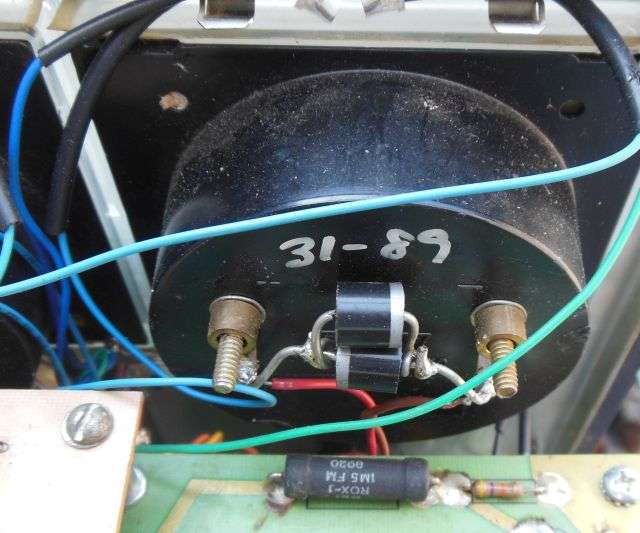
Oh, and here's how you can tell it's an Ameritron. Just unsolder the green wire from the ground lug to get 10 meters.
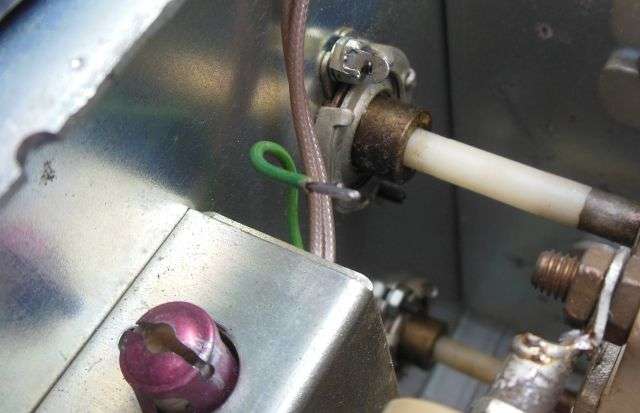
This has become an incredibly useful tool. The answer to "should we spend 200 bucks to fix this power supply?" can be answered with more confidence when the tubes prove to be working like they should. BEFORE the rest of an amplifier gets money pumped into it. Much better than finding out the tubes are flat AFTER money gets spent to revive an amplifier.
73
Not a kit, the Heathkit name was just a marketing "badge" applied to the AL-80A amplifier built by Ameritron of Ohio, just before the Ameritron name and catalog were sold to Martin of MFJ and moved to Mississippi.
Here's a stock shot of the front.

Yeah, Heath was already on the ropes for the first time when this was sold around 1988 or so. They had discontinued their ham gear years before, but Ameritron had been, er, "bought" from Dennis, the "Amp Supply" and "Dentron" guy and moved from North Carolina to Ohio. It's easy to imagine that if Heath offered to buy a production run of AL-80A amplifiers with their front-panel artwork on it, Ameritron would be happy to sell them.
Stock inside shots:


And Dennis Had was still in North Carolina last I heard, making tube-type audio gear. Said he would never design another product for ham radio again as long as he lives.
It's not the original "AL80" from North Carolina. And it's not the "AL80B" that MFJ redesigned to make in Mississippi. This one is the in-between "AL-80A" model in disguise.
Not sure why, but when you find one of these for sale the power transformer is nearly always croaked. This one was. Made the purchase price quite reasonable. The search was on for an affordable replacement. Ended up using the transformer that Ameritron sells as the replacement for the current-day AL80B.
But it won't fit. It's bigger, which should be a good thing. You might be tempted to guess that the factory transformer was too small, and that's why they all go bad after 20 years or less. But a quick comparison the the stock HV transformer in the two-tube SB-220 model shows that they're nearly the same size.
Go figure. The price is right for the Ameritron 406-1109-2C transformer. Cheaper to buy directly from them than any other source of the same or similar part

First challenge is to make it fit. It's larger. The filter capacitor board gets moved about a half-inch towards the front. Since we replaced the tall "computer grade" filters with smaller snap-in style filter caps there is room to mount a ChinaBay soft-start board on the deck under them.


One reason to rehab this amplifier was to use it for testing tubes at full power. I can test them cold for gas and shorts, but I needed a way to match tubes for zero-bias idle current and to see how much power a tube can deliver. No other effective method to see if a used tube is weak. And finding out that one of a pair of tubes is twice as strong as the other is equally bad news.
But putting a used tube in an amplifier can create a hazard to the amplifier if it goes "SNAP!" when you key it. Most of what we did to upgrade this one was to make it resist damage from a tube that breaks down under load.
Next strategy is to upgrade the high-voltage rectifier diodes to 6-Amp rated parts. This is overkill for the normal load current, but increases the surge rating of the power supply. The original setup used only two strings of five diodes. We doubled up each single diode as a series pair. Doesn't improve the current rating, since they are all in series. But it cuts the reverse voltage on each diode in half. The original power-line fuses are now 7.5-Amp breakers. I suspect that a fair number of 'bad' SB-1000 transformers were croaked by a "no-blow" fuse.

The original plate choke is very different from the one that Ameritron uses. It was roached, so we installed the current-day AL80B choke, also bought from Ameritron.
Original:

Replacement:

A large "glitch" resistor is now in the high-voltage line between the power supply and the plate choke. It's built from a series string of eight 25-ohm 30-Watt wirewound resistors. Adds up to 200 ohms at a theoretical power rating of 240 Watts. They're spaced way too close to get that full power rating. You have to expose all of the resistor's surface to circulating air to get that rating. But with the amplifier running at 1000 Watts DC input to the tube this is only 1/3 of an Amp, more or less. At this power level, each resistor only has to dump a little under 3 Watts. The voltage drop through 200 ohms from the high voltage would only be 66 Volts. Losing 66 Volts out of 3000 is not enough to sacrifice performance in any significant way. And Ohm's law says that the max surge current the tube can draw from 3000 Volts is now 15 Amps. Way more than is safe for the tube, but not too hard on the 6-Amp rectifiers or the plate choke, so long as the breakers trip out promptly.

A dead-shorted tube should not damage the amplifier's power supply.
The Ameritron 406-1109-2C power transformer supplies all the operating voltages needed for HV, tube filament, relay and lights. But it's meant to be used all over the planet and to accommodate all manner of wacky line voltages. The hookup we ended up using to match a 240-Volt power line voltage was a combintion of educated guesswork and trial-and-error. We did *NOT* make any attempt to figure out a 120-Volt setup. No point.
These 7.5-Amp breakers should be sufficient.

The original 10-Watt zener diode used for fixed cathode bias is gone, replaced with a board full of 3-Amp 1N5408 rectifier diodes in series. The bias-voltage regulation is not quite as good as a zener, but 3-Amp rectifiers are a lot tougher than a 10-Watt zener diode, and should not be damaged by a brief surge. The other advantage of using this bias board is the knob added to the front panel that selects the bias voltage on the tube. It's wired for zero bias, 5, 10 and 20 Volts of cathode bias. The zero bias setting is useful for tube matching. The number written on a paper tag glued to a new chinese 3-500Z is the zero-bias plate current for that tube. Not sure what plate voltage they use to make that measurement, but it does permit comparison from one tube to the next for matching purposes.

Either 5 or 10 Volt bias is fine for SSB. It will breathe a lot easier on AM with 20 Volts. This ugly knob selects one of four bias modes. It mounts in the hole where the "TX" indicator used to be. Much easier than lining up a new hole in both the chassis and faceplate.

The one remaining item on the modification wish list is to beef up protection for the meters. A current surge from a bad tube can damage either or both meters. A back-to-back pair of diodes will do the job as a rule, but I would rather have a 'sacrificial' 1/4-Watt resistor in line with each meter to serve as a fuse. This is still a work in progress. Ought to write up the rules for protecting analog meters this way.
Later.

Oh, and here's how you can tell it's an Ameritron. Just unsolder the green wire from the ground lug to get 10 meters.

This has become an incredibly useful tool. The answer to "should we spend 200 bucks to fix this power supply?" can be answered with more confidence when the tubes prove to be working like they should. BEFORE the rest of an amplifier gets money pumped into it. Much better than finding out the tubes are flat AFTER money gets spent to revive an amplifier.
73
